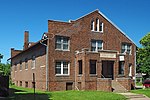St. Stefan's Romanian Orthodox Church
20th-century Eastern Orthodox church buildingsChurches completed in 1924Churches in Dakota County, MinnesotaChurches on the National Register of Historic Places in MinnesotaEastern Orthodox church stubs ... and 8 more
Eastern Orthodox churches in MinnesotaMinnesota Registered Historic Place stubsMinnesota church stubsNational Register of Historic Places in Dakota County, MinnesotaRomanian-American historyRomanian Orthodox church buildingsUnited States church stubsUse mdy dates from August 2023

St. Stefan's Romanian Orthodox Church is a historic church built in 1924 in South St. Paul, Minnesota, United States. It was built for Romanian American immigrants who worked in the meatpacking industry. It continues to serve as a Romanian Orthodox Church.. The patriarchal chair is currently held by Daniel I, Archbishop of Bucharest, Metropolitan of Muntenia and Dobrudja (former Ungro-Wallachia) and Patriarch of All of the Romanian Orthodox Church.[
Excerpt from the Wikipedia article St. Stefan's Romanian Orthodox Church (License: CC BY-SA 3.0, Authors, Images).St. Stefan's Romanian Orthodox Church
Grand Avenue West,
Geographical coordinates (GPS) Address Nearby Places Show on map
Geographical coordinates (GPS)
| Latitude | Longitude |
|---|---|
| N 44.895555555556 ° | E -93.038888888889 ° |
Address
Grand Avenue West 353
55075
Minnesota, United States
Open on Google Maps







